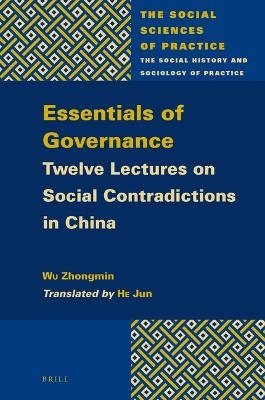
Essentials of Governance
Brill (Verlag)
978-90-04-46840-5 (ISBN)
There are twelve lectures in this book. The theoretical section addresses the concept of social contradictions, their various forms and influencing factors, their dual functions and how they aid social development. The author then compares the characteristics of contradictions in traditional and modern society, and analyzes how their special laws have become applicable during periods of transition in contemporary Chinese society. He interprets the contradictions between the public and officials, the rich and the poor, and labor and capital. He also looks at social contradictions in the internet era. He finally analyzes the possibility of social unrest in China and proposes how to actively and effectively deal with social contradictions. His study of social contradictions is of theoretical and practical significance.
Wu Zhongmin is a professor at the Party School of the Central Committee of CPC. His main works include: The Theory of Social Justice, Towards a Just Chinese Society, The Theory of China's Social Development, and The Theory of China's Modernization.
Series Editor’s Note
Translator’s Note
1 Not All Contradictions in Society are Social Contradictions
1 The Concept of Social Contradictions at Macro and Micro Level
2 The Concept of Social Contradictions at Meso-Level
2.1 A Problem at the Structural Level of the Social Stratum
2.2 There are Concerned Parties That Interact or Communicate Their Interests
2.3 The Interactions between Parties Involved in Social Contradictions Show Consistencies as Well as Inconsistencies
3 The Difference between Social Contradictions, Social Conflicts, and Social Movements
4 The Difference between Riots and Social Unrest
4.1 Whether or Not It is Subversive
4.2 Whether There is a Violent Confrontation
4.3 Whether It is Destructive on a Large Scale
5 Conclusion
2 The Important Influence of Non-Material Interest Factors on Social Contradictions
1 A Definition of Non-Material Benefits
2 Contradictions with Non-Material Benefits Have Dual Effects
3 The Stimulating Effect of Extreme Spiritual Factors on Intense Social Contradictions
3 The Important Influence of the Structure of Social Power Contrasts on Social Contradictions
1 The Influence of the Resisting Party’s Specific Situation on Social Contradictions
1.1 The Weight of the Opposition Party’s Influence on Society
1.2 The Internal Integration of Resistance Forces
1.3 Whether the Economic Situation Has Changed or Not
2 The Influence of the Ruling Party’s Specific Situations on Social Contradictions
2.1 The Credibility of the Ruling Party
2.2 The Power of Control of the Ruling Party
2.3 The Ruling Party’s Own Degree of Integration.
3 The Influence of the Middle Party’s Situation on Social Contradictions
4 The Strength of Social Contradictions Related to Party Conflict and Other Influential Factors
4 How Social Contradictions Force Social Development
1 Social Contradictions Have Dual Functions and Aid Social Development
2 Social Contradictions Force Social Development
2.1 Social Contradictions Promote the Continuous Improvement of Social Justice
2.2 The Aggravation and Escalation of Social Contradictions Will Often Become an Important Opportunity for New Arrangements of Interests
2.3 Social Contradictions Can Effectively Promote the Development and Perfection of Institutions
2.4 The Prominence of Specific Social Contradictions Can Often Indicate a Fault or a Shortcoming in Society
2.5 In Certain Conditions, Social Contradictions Can Lead to Discontent and the Accumulation of Resentments
3 The Necessary Conditions for Social Contradictions to Force Social Development
3.1 The Parties Involved in Social Contradictions, Especially Influential Ones, Cannot Fall Into an Irrational State
3.2 Most Social Groups Have a Relatively Broad Consensus on Future Prospects
3.3 The Right Policies are Launched at the Right Time
5 A Comparison of the Contradiction Characteristics in Traditional and Modern Society
1 There are Obvious Differences in How Probable Social Contradictions Are
1.1 There are Great Differences between Traditional and Modern Societies With Regard to Social Energy and the Pace of Change
1.2 There Are Different Degrees of Complexity in Traditional and Modern Societies
2 The Different Basic Causes of Social Contradictions
3 The Manifestations of Serious Social Contradictions Are Obviously Different
4 The Ability to Resolve Social Contradictions Differs Greatly
4.1 Modern Society Has Relatively Reasonable and Stable Systems
4.2 Modern Society Has a Strong Ability to Absorb Social Contradictions
4.3 Modern Society’s Institutions Can Keep Pace with the Times in Handling Social Contradictions
6 Key Features of Social Contradictions in Modern China
1 Peoples’ Livelihood Outweighs Political Appeals
2 Outstanding Conflicts between the Government and its Citizens
3 Individual Cases Often Turn Into Social Conflicts
4 The Methods of Appeal Are Mild
5 Dilemmas in Solving Social Contradictions
6 There is a High Probability That Social Contradictions Will Increase in Intensity
7 Special Topic: Guarding against Lone Wolf Terrorist Attacks in China’s Mainland
7 Key Features of “Public versus Officials” Contradictions in Modern China
1 Contradictions between the Government and the People Occupy an Important Position Among Social Contradictions as a Whole
2 Contradictions between the Government and the People Are Increasingly from Top to Bottom
3 Some Disputes between Officials and Civilians are Social Contradictions Rooted in Anger
4 Contradictions between the Government and the People Show Signs of Ossification
4.1 In the Distribution of Revenue
4.2 Barriers are Beginning to Form between Government Officials and Citizens
5 The Lack of Institutions and Mechanisms for Resolution
5.1 There are No Effective or Smooth Mechanisms to Respond to People’s Interests and Demands
5.2 The Institutional Mechanisms to Deal with Social Contradictions are Often Missing
6 Contradictions between the Government and the People are Non-Confrontational
6.1 The Chinese Communist Party Still Having the Legitimacy to Govern
6.2 The Way People Appeal for Their Interests is Generally Moderate
6.3 The Public Generally Trusts Officials
8 Key Features of Contradictions between Rich and Poor in Contemporary China
1 The Core Contradiction between Rich and Poor Lies in the Social Structure
1.1 The Inequality of Status, Influence, and the Right to Speak among Different Social Groups
1.2 Alliances Created in the Interest of Elite Political and Economic Groups
1.3 Encroachments on the Actual Interests of the Disadvantaged
2 The Inability of Government to Fulfil Its Responsibilities of Public Service
3 The Chinese People Care More about the Gap between the Rich and the Poor
4 Contradictions between the Rich and the Poor are Negative, Extensive, and Profound
5 Contradictions between the Rich and the Poor are at a Critical Turning Point
6 Special Topic: Distinguishing Two Types of Contradictions between the Rich and the Poor
9 Key Features of Contradictions between Labor and Capital in Contemporary China
1 There are Problems between Labor and Capital at the Level of Institutions
1.1 The Government Does Not Sufficiently Support Workers
1.2 There is a Clear Absence of Trade Unions
1.3 The Lack of a Policy on Strikes
1.4 A Lack of Functions in Employers’ Organizations
2 Labor-Capital Asymmetry
2.1 There are Obvious Problems for Laborers When Signing Labor Contracts
2.2 Labor Income is Not Proportionate to Labor Input
2.3 Security Conditions are Poor For Laborers
2.4 The Situation Regarding Social Security is Still Worrisome
3 Workers’ Interests are Mainly Economic
4 Laborers Pursue Their Interests in a Relatively Moderate Way
4.1 Expressing Interests within the Framework of Laws and Regulations
4.2 Expressing Interests through Peaceful Means Such as Sit-ins, Petitions, and Marches
4.3 Expressing Interests and Demands through Work Stoppages and Strikes
4.4 Using a Decentralized, One-on-one Approach
4.5 Workers Hope to Solve Their Problems and to Coexist with Management
4.6 Labor Contradictions are Basically Related to Economic Interests Rather than Political Power
4.7 At Present, the Circumstances of China’s Workers are Unique
4.7.1 Workers Have a Relatively Strong Capacity for Endurance
4.7.2 Most Workers are Concerned about Their “Security” When Expressing Their Demands
4.7.3 Most Migrant Laborers Still Have Their Basic Source of Livelihood
10 Key Features of Social Contradictions in the Internet Era
1 The Concurrence of Equality and Inequality
1.1 Interest Groups Such as Internet Developers and Access Companies are Controlling Internet Users
1.2 The Inequality of Online Voices
1.3 Cyber Violence
2 How the Internet Fuels Social Contradictions
2.1 Users Tend to be More Reckless When They are Anonymous
2.2 Reckless Communication among Internet Users Facilitates Anger and Stimulates Irrationality
2.3 Efficient Internet-based Tools Can Facilitate the Rapid Formation of Certain Social Contradictions
3 The Internet is an Effective Magnifier of Social Contradictions
3.1 Comments and Complaints
3.2 Diverse Opinions and Angry Forms of Expression
3.3 The Rapid Shifting of ”Trends”
4 The Positive Role the Internet Can Play in Mitigating Social Contradictions
4.1 By Illuminating Public Opinion, an Important Indicator of Social Contradictions
4.2 The Internet Can Help Relieve How People Feel about Social Contradictions
4.3 The Internet Can Effectively Prevent and Rectify Abuses of Power
5 Conclusions
5.1 In the Internet Age, Social Contradictions Will Necessarily Possess Certain Characteristics
5.2 Social Contradictions on the Internet Reflect Real-life Contradictions
5.3 The Internet Has Both Positive and Negative Influences on Social Contradictions
5.4 Regulating the Internet
11 The Possibility of Social Unrest in China
1 The Birth of Social Unrest
2 Social Integration
2.1 The Government is Good at Dealing With Social Contradictions
2.1.1 The Government Itself is Good at Maintaining Control
2.1.2 The Government Has a Strong Spirit of Pragmatism and the Ability to Keep Pace With Social Change
2.1.3 The Government Has a Strong Capacity for National Mobilization
2.2 The Basic Attitude of the People is Conducive to Social Integration
2.2.1 The People Still Have a Basic Level of Trust in the Government
2.2.2 People’s Interests are Mainly Related to Their Basic Livelihoods, Not Politics
2.2.3 People Value and Have Confidence in Social Stability
2.2.4 People’s Interests and Demands are Mainly Manifested in Non-violent Activities
2.3 Extremist Thought is Unlikely to Develop
2.3.1 It is Plausible to Suggest that Extremist Ideologies Cannot Exist in Chinese Society
2.3.2 Extreme Racism Has No Historical Basis in China and Has Never Occupied a Dominant Ideological Position
2.3.3 Fundamentalist Religious Ideologies Also Lack a Historical Basis and the Potential to Grow in China
3 The Fundamentals of Economic Development
3.1 An Autonomous Economic System
3.2 The Stability of Economic Order
3.3 The Sustainability of Economic Development
4 The Basic Living Conditions of the People
4.1 People’s Basic Living Standards Have Greatly Improved
4.2 The Country Has the Ability to Deal Effectively With Any Rapid Deterioration of People’s Basic Living Conditions
4.3 The Overall Trend is toward Improving People’s Livelihoods
12 Actively and Effectively Dealing with Social Contradictions
1 Safeguarding and Promoting Social Justice
1.1 Social Justice is the Basis for institutional Arrangements
1.2 Maintaining Social Justice is Important in Alleviating the Gap between the Rich and the Poor
1.3 Social Justice is Conducive to the Formation of a Mutually Beneficial Structure of Social Interaction
1.4 Safeguarding Social Justice is the Key to Creating an “Olive-shaped” Social Structure
2 Actively Protect the Basic Rights of Every Member of Society
2.1 Safeguarding people’s basic rights helps people identify with society
2.2 Maintaining the Basic Rights of Members of Society Can Effectively Prevent the Expansion of Public Power
3 Actively Develop Social Organizations
3.1 They Can Resolve Many Social Disputes and Contradictions in the New Era
3.2 They Can Provide a Buffer between the People and the Government and Avoid Direct Clashes between Them
4 Making Use of China’s Unique Advantages to Deal with Social Contradictions
4.1 Ordinary People Long for Stability
4.2 The Country Has a Strong Capacity for Mobilization
4.3 The Tradition of Pragmatism, Peacefulness, and Tolerance
4.4 The Important Buffering Effect of the Family
Index
| Erscheinungsdatum | 19.07.2021 |
|---|---|
| Reihe/Serie | The Social Sciences of Practice ; 8 |
| Übersetzer | Jun He |
| Verlagsort | Leiden |
| Sprache | englisch |
| Maße | 155 x 235 mm |
| Gewicht | 501 g |
| Themenwelt | Sozialwissenschaften ► Soziologie ► Allgemeines / Lexika |
| Sozialwissenschaften ► Soziologie ► Makrosoziologie | |
| ISBN-10 | 90-04-46840-4 / 9004468404 |
| ISBN-13 | 978-90-04-46840-5 / 9789004468405 |
| Zustand | Neuware |
| Haben Sie eine Frage zum Produkt? |
aus dem Bereich


